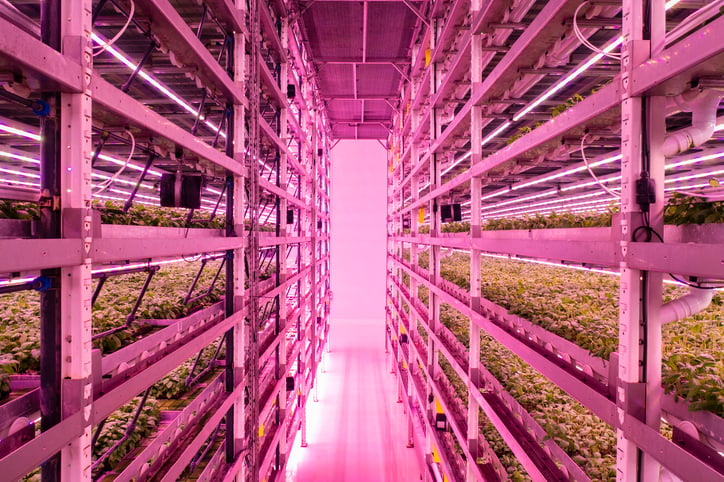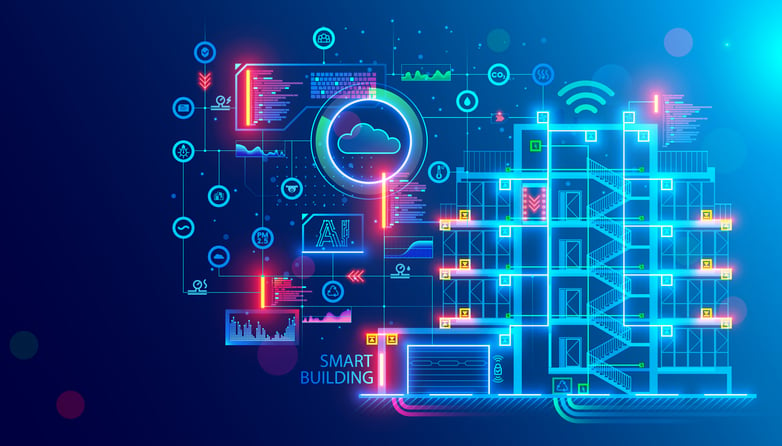Revolutionizing Indoor Farming With IOT Agriculture Sensors

The way agriculture happens is changing. In fact, it's gaining ground in a familiar environment: the great indoors.
In recent years, indoor farming has taken off and is becoming increasingly popular due to its ability to produce high-quality crops while using limited amounts of space, resources, and energy.
The shift to indoor agriculture operations – though not new – is becoming a necessity as traditional agriculture is facing challenges to its sustainability and ability to meet demand.
For those managing an indoor agriculture operation of any sort, there's nothing more important than maintaining as much control as possible over the environment. Just like growing fruits and vegetables outdoors (or raising livestock), even one small change in growing conditions can have a major impact on a successful harvest.
That's where IoT agriculture sensors come in.
When carefully integrated into the systems and environments of indoor agricultural operations, IoT sensor technology gives next-gen farmers the upper hand in optimizing growing conditions for maximum crop production and yield.
For the purpose of this article, we'll zero in on indoor vegetable growing. Keep in mind: many of the same benefits advanced sensor technology brings to managing controlled environment vegetable farming can be applied to indoor livestock operations as well.
The Ongoing Evolution of Agriculture
The state of agriculture is in an interesting and transitional time.
Traditional farming isn't what it used to be.
Consider:
-
In 2023, there were only 1.89 million farms in the U.S. – less than a third of a 6.8 million-farm peak almost a century earlier.
-
In the last five years, the number of farms in the U.S. decreased by 141,733, and the decline is poised to continue through the coming decades. The same is expected globally for the rest of the century.
-
Farmable land is decreasing year over year, and that's not expected to change any time soon.
Yet the need for produce and livestock products has not gone away, nor will it. The simple fact is that people need to eat, and almost all the food that stocks grocery store shelves can trace its roots back to a farm.
What's more, eating habits are changing, with more people worldwide choosing plant-based diets.
So how do you feed a hungry planet against the challenges faced by traditional agriculture?
The answer is essentially bringing the farm indoors.
Controlled environment farming operations, which encompasses indoor growing practices such as hydroponic and vertical farming, are becoming more common. And, pardon the pun, it's an industry that's only expected to grow.
The success of controlled environment farming largely depends on one major thing: controlling the indoor environment so it's conducive to growing plants.
And it's not just advanced sensors that help climate control systems keep indoor environment metrics within appropriate ranges. Now, it's IoT- (Internet of Things) enabled advanced sensors integrated into HVAC, lighting, and irrigation systems that make this latest iteration of agriculture possible.
What Are IoT Sensors & How Do They Work?IoT sensors in indoor agriculture are sophisticated devices designed to capture and relay data on environmental conditions and transmit it to a central processing system. This system analyzes the data to provide actionable insights and engage various indoor climate control systems to optimize conditions for crop development and health. |
The IoT Agriculture Sensors That Make Indoor Farming Fruitful
Although indoor growing operations are each unique, the IoT agriculture sensors enabling controlled environment farming are consistent across all enclosed agricultural spaces.
Keeping indoor environmental conditions within an ideal range means monitoring and controlling a combination of factors that, in a grand sense, mimic the dynamics of the natural environment. While it's impossible to duplicate things like the sun, wind, and weather patterns, IoT sensors integrated into the systems controlling an indoor environment make it possible to get pretty close. With their data helping to automate and engage climate control systems, controlled environment farms can meet the needs of what's being grown on demand.
Whether you're designing or upgrading any one of an indoor farm's climate control systems, the IoT agriculture sensors that are a must for any operation include:
-
Humidity Sensors for keeping ambient airborne moisture levels in check, thereby promoting plant disease prevention and optimal growth conditions.
-
Temperature Sensors to ensure the indoor farming environment remains within the optimal temperature range for plant growth.
-
Indoor Air Quality Sensors to monitor the concentration of airborne pollutants, including CO2, and the overall air quality within the indoor farming setup. At the same time, keeping CO2 levels within a precise range is critical to photosynthesis and, in turn, a healthy crop.
-
Light Sensors for monitoring natural and artificial light levels in indoor farming settings.
-
Soil pH Sensors to measure the acidity or alkalinity of the soil, a crucial factor in nutrient availability to plants.
-
Leaf Color Sensors to assess plant health. Changes in leaf color can indicate nutrient deficiencies, water stress, or disease.
IoT Sensors for Precision Agriculture & a Bountiful Harvest
There's no such thing as too much data.
This is especially true – and practically a necessity – for indoor agriculture.
The more actionable data farmers have on the growing environment and crops from things like smart greenhouse sensors, the more they can fine-tune climate control and growing systems with pinpoint accuracy for:
-
Creating Optimal Growing Conditions: Constant monitoring and adjustments made possible by IoT sensors maintain ideal conditions for plant development, directly contributing to higher yields and superior quality crops. An example: Data collected by temperature and moisture sensors in agriculture can be used to create better irrigation schedules that provide plants with the right amount of water.
-
Enhancing Crop Monitoring and Management: Real-time data from IoT sensors help paint an accurate picture of crop health and environmental conditions, enabling immediate adjustments to improve plant growth and prevent issues from escalating. For instance, a spike in humidity levels can be quickly mitigated by the indoor farm's HVAC system to prevent plant diseases.
-
Reducing Energy, Water Use, and Waste: With the help of IoT sensors, indoor farming operations have better control over resource use. This not only helps reduce costs but also minimizes environmental impact by conserving energy and water resources and reducing waste.
-
Increasing Productivity With Decreased Labor: Creating wireless sensor networks in agriculture through IoT technology all-but-eliminate the need for manual monitoring and data collection, freeing up farmers to focus on other important tasks. This eliminates human error in data collection and enables better decision-making based on accurate information.
Bringing IOT Ag Sensors to Your Indoor Growing Operation
Adding advanced sensor technology to climate control systems of any sort is nothing new. In fact, it's something that most designers and manufacturers already do to make sure their systems are running at peak performance and efficiently.
In indoor agriculture, the stakes are a little different, as sensors for agriculture and environmental monitoring require a higher level of precision and immediate reactivity.
Your best bet for adding IoT agriculture sensors to your indoor farming climate control systems?
Partner with an advanced sensor manufacturer.
Working directly with the manufacturer, you’re able to benefit from:
-
Customization: Manufacturers can provide tailor-made solutions that fit the unique requirements of an indoor farming operation. Unlike off-the-shelf products, custom sensors can be designed to measure specific parameters relevant to plant health and growth, ensuring more accurate and efficient monitoring and control.
-
Integration: Advanced sensor manufacturers have the expertise to ensure seamless integration of their products into existing indoor farming systems. They can offer guidance on incorporating sensors with other components of the climate control system, such as HVAC units or irrigation systems, for cohesive operation.
-
Innovation: Direct collaboration with manufacturers gives indoor farming operations access to the latest sensor technologies and innovations. Manufacturers often invest heavily in research and development, meaning clients benefit from cutting-edge solutions that offer improved accuracy, reliability, and functionality.
-
Support: Establishing a direct relationship with a sensor manufacturer ensures ongoing support and advice. This can be invaluable for troubleshooting, updates, and scaling the sensor network as the indoor farming operation grows or evolves.
-
Cost-effectiveness: While custom solutions may seem more expensive upfront, they can offer greater cost-effectiveness in the long run by optimizing resource use, reducing waste, and enhancing crop yields.
A Look Ahead at Farming 2.0
While it's impossible to know exactly what agriculture will look like in the future, there is one simple reality that we're witnessing now: how we farm is changing.
Indoor agriculture is not just a trend; it's a sustainable approach here to stay and poised for further growth.
Looking ahead at what's to come, the next wave of innovations in IoT for agriculture is expected to bring even more sophisticated sensors, enhanced connectivity solutions, and advanced analytics tools, all designed to increase the efficiency and productivity of indoor farming operations.
In addition, the integration of artificial intelligence and machine learning technologies is set to play a major role in advancing indoor farming. These technologies will enable even more precise monitoring and management of environmental conditions, optimize resource use, and improve crop yields through predictive analytics and automated decision-making processes.
And yes, sensors used in smart agriculture will indeed be a major component of next-gen agritech.
IoT Agriculture Sensor: Pushing Farming Forward
Agriculture is not unlike any other industry – it's always subject to change.
Given the new challenges facing traditional farming and the growing demand for sustainable agriculture, controlled environment farming is the future.
With IoT agriculture sensors bringing a new level of control to this type of farming, it's an exciting time to be a part of the industry as it evolves.
Bring Advanced Sensor Tech to Your Indoor Farming Operation
Speak with one of our sensor engineers today:




